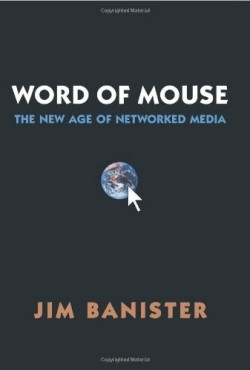Word of Mouse
The New Age of Networked Media
Many people see technological advances as a smooth linear process. A new product is introduced, commercial applications are discovered, and the new technology is embraced, then improved upon as the price drops to a level where the customer embraces the new product as familiar and necessary. In reality, technology moves at a lumpy pace: products die on the shelf and are replaced by inferior versions or simply die away altogether. It has been suggested that there is typically at least a twenty-year gap between the time a revolutionary invention is introduced and the time the target audience understands how it can be used. This book examines in fascinating detail how networked media has passed through the early exploratory stages and is poised to create as radical a change in culture as the commercial development of electricity.
A network is a human distribution system. Networked media is information that is distributed by digital networks and can be acted upon in the marketplace. What makes networked media such a powerful innovation is its ability to allow people to define what they wish to purchase, whether that purchase is a single song from Napster, or a single paragraph from an industrial report. What makes Banister’s book so interesting is how compellingly and clearly he defines networks as human activities, and how well he communicates what makes networks function. Banister, a media industry insider who has worked with companies such as Disney, the BBC, and Warner Brothers, clearly understands the dynamics of how culture and technology intersect, and has some important ideas on what makes these intersections valuable.
Word of Mouse has many startling insights. In one example, Banister discusses how human activities have always tended to organize into networks. Consider alcohol prohibition and the distribution networks that arose to bypass government interdiction, or in another example, the current illegal drug trade. These observations bring the Internet into greater focus as an extension of human culture.
Banister looks at the ingredients necessary to make innovation revolutionary. He calls these ingredients the “Four C’s”: content, community, commerce, and code. Banister very cogently argues that all four C’s must be developed in order for a technology to become pervasive. In the 1990s many companies were strong on content, code and community, but without a means of commercializing on the sales of data. Banister very clearly makes a case for the commerce of data.
It is a pleasure to see how coherently Banister interprets the present directions in technology as a way of envisioning the future. This is an important book.
Reviewed by
Peter Terry
Disclosure: This article is not an endorsement, but a review. The publisher of this book provided free copies of the book to have their book reviewed by a professional reviewer. No fee was paid by the publisher for this review. Foreword Reviews only recommends books that we love. Foreword Magazine, Inc. is disclosing this in accordance with the Federal Trade Commission’s 16 CFR, Part 255.

